Is Stockholm worth visiting? Discover the must-see attractions of the Swedish capital
What to do in a day
Of course, it’s worth visiting Stockholm even in winter for a day: here are the best places and attractions to see, and things to do.
We had an unforgettable experience right in the heart of the old town.
Strolling through the cobbled streets of Gamla Stan felt like stepping back in time, surrounded by colourful buildings, breathtaking views, and a truly unique atmosphere.
Is Stockholm worth visiting? Without a doubt – and even more so in winter, when the city takes on a magical charm. Snow-covered landscapes and soft, glowing lights turn every corner into a picture-perfect scene.
Our PDF travel guide, complete with suggested itineraries and an interactive map, will walk you through the city’s must-see highlights:
- The most interesting museums
- Green city parks for a relaxing break
- The best walking routes to enjoy the city on foot
We visited Stockholm in February, but it is a beautiful place all year round.
For our stay, we chose the Generator Hostel, a modern and well-organised place in a strategic location – just minutes from the central station and steps away from the lively pedestrian area of Norrmalm.
Our private double room was clean, comfortable, and offered excellent value for money – perfect for both young travellers and anyone looking for a smart, functional solution.
Stockholm is a city to explore at your own pace, where every corner surprises you with a perfect blend of tradition and modernity.
Our online guide:
From the central railway station we walk through the exclusive Strandvägen street, located in Stockholm’s most luxurious district. First we make a small halt at Kungsträdgården to sip a cappuccino in this beautiful park.
We proceed to Östermalm, an elegant neighborhood with its magnificent palaces and tree-lined boulevards with walking and cycle trails.
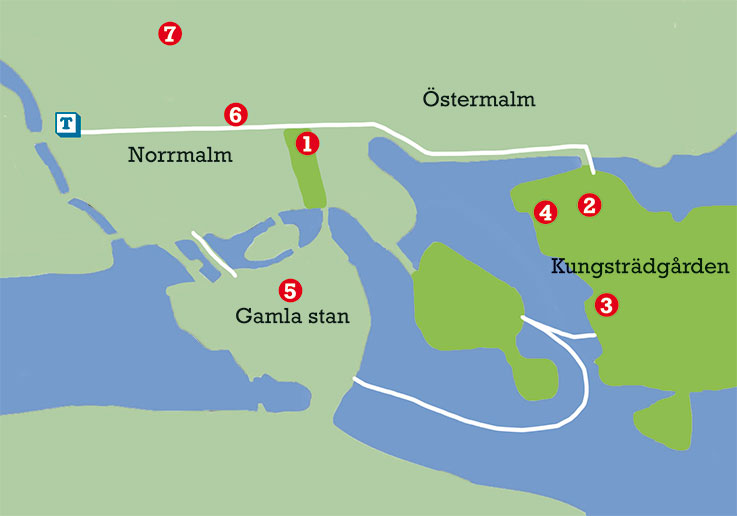
Ticino, 6986, 14.11.2020
1 Kungsträdgården
2 Nordiska museet
3 Abba Museum
4 Vasa Museum
5 Storkyrkan
6 Sergels torg
7 Hötorget
From the Central Station to Östermalm
Starting from the Central Train Station, the beating heart of the city’s transport network, we begin our walk towards one of the most refined areas of Stockholm.
We make our way along Strandvägen, one of the most iconic and prestigious streets in the city, often considered the most exclusive.
Lined with elegant historic buildings, luxury hotels, and yachts moored along the canal, this street showcases the most sophisticated side of the Swedish capital.
Here, we find ourselves in the heart of Stockholm’s most upscale district, where refined architecture blends harmoniously with the urban landscape.
Before continuing, we take a pleasant break at Kungsträdgården, one of the parks most loved by locals.
This green space, just a short walk from the city centre, is the perfect spot to relax with a cappuccino in hand, perhaps sitting on a bench in the shade of the trees or at one of the outdoor cafés that bring the area to life—especially on sunny days.

Refreshed after our pause, we continue towards Östermalm, one of the most elegant and well-maintained neighbourhoods in the city.
The wide, tree-lined avenues, perfectly equipped with cycle lanes and spacious pavements, make for an especially enjoyable stroll, allowing us to take in the calm and orderly rhythm of this distinguished area of Stockholm.
The treasured museums of Djurgården
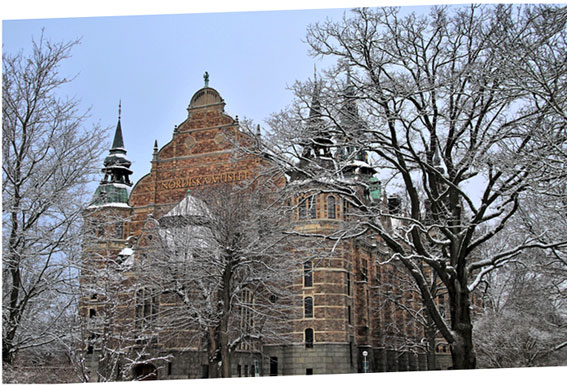
Continuing our itinerary, we head towards the bridge that opens up on the right — a pedestrian and vehicular crossing that connects the mainland to the enchanting island of Djurgården.
This island, one of the greenest and most peaceful in Stockholm, is a true gem for lovers of nature, culture, and outdoor walks.
Once across the bridge, we find ourselves immersed in a landscape of centuries-old trees.
Djurgården is well known for its vast park, much loved by both tourists and locals.
But Djurgården is also an important museum hub, rich in high-level cultural attractions.
Among these stands out the majestic Nordic Museum (Nordiska museet), housed in an impressive Renaissance-style building that alone is worth a visit.
This museum is dedicated to the history and traditions of the Nordic peoples, and it vividly and accurately recounts the evolution of everyday life in Sweden from the 16th century to the present day.
In Stockholm, an unmissable stop for all fans of the famous Swedish group ABBA is undoubtedly ABBA The Museum.
This interactive museum allows visitors to immerse themselves completely in the world of the legendary band: inside, one can admire original stage costumes, musical instruments, gold and platinum records, as well as a rich collection of memorabilia and artefacts that tell the story of their extraordinary career.
Visitors can even sing, dance, and record themselves performing some of their most famous songs, experiencing what it feels like to be, for a day, the fifth member of ABBA.
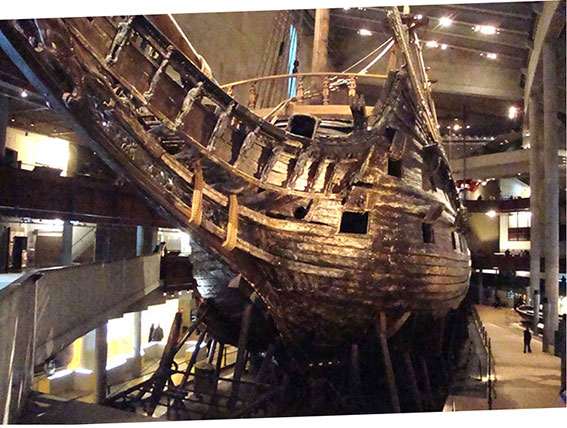
Stockholm’s most fascinating and unmissable attraction is without a doubt the Vasa Museum, which houses the magnificent warship Vasa — a true 17th-century marvel.
This extraordinary vessel, launched in 1628, tragically sank in Stockholm harbour just minutes after its maiden voyage, only to be salvaged 333 years later from the bottom of the Baltic Sea.
Thanks to meticulous restoration work, the Vasa has been reassembled piece by piece and now stands proudly inside a vast purpose-built pavilion designed to showcase it in all its splendour.

VASA MUSEUM and other interesting attractions to see in Stockholm
Gamla stan and its historical center
Just a few minutes from the ABBA Museum, a short and pleasant boat ride takes you to the evocative island of Gamla Stan — the ancient heart of Stockholm and the official residence of the King of Sweden.
Strolling through its cobbled streets is a relaxing and captivating experience: every corner reveals colourful buildings, artisan workshops, small art galleries, and picturesque views that tell stories of centuries past.
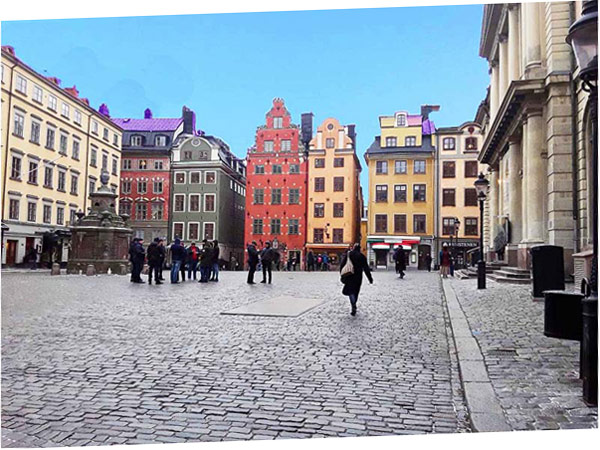
Gamla Stan is also the perfect place for a gastronomic stop: modern bistros serve creative takes on traditional Nordic dishes, while trendy pubs and bars offer the ideal setting to enjoy a cocktail in an elegant and welcoming atmosphere.
Unmissable, of course, are the famous Swedish meatballs (köttbullar), served with creamy sauce and lingonberry jam.
Between one stroll and another, it’s well worth visiting the medieval Cathedral of Storkyrkan, with its Gothic interiors and beautiful works of art that make it one of the city’s most significant landmarks.
Gamla Stan encapsulates all the charm of Stockholm — history, culture, and modernity coexisting in perfect harmony.
Norrmalm with its fruit and vegetable market
After visiting the enchanting Gamla Stan, cross the Vasabron Bridge, which connects the old town to the lively district of Norrmalm — the modern, bustling heart of Stockholm.
Continuing on foot towards Sergels Torg, you reach one of the most famous squares in the Swedish capital, a symbol of contemporary Stockholm, characterised by modern architecture, shopping centres, and a vibrant, cosmopolitan atmosphere.
Between the two main streets, Drottninggatan and Sveavägen, lies Hötorget Square, renowned for its open-air fruit and vegetable market.
It’s the perfect spot to take a tasty break — perhaps by sampling a typical Swedish snack or an international dish freshly prepared on the spot — while soaking up the lively atmosphere of the market.

Stockholm, with its perfect blend of history and modernity, offers unforgettable experiences in every season.
In winter, the city takes on a special charm: lights reflecting on the snow, cosy cafés, and festive decorations create a magical and unforgettable atmosphere.
Sweden, with its unspoilt nature, refined culture, and the warmth of its people, is truly an extraordinary country waiting to be discovered.
Download our PDF guide, take the map with you, and get ready to explore one of the most fascinating capitals in Northern Europe!
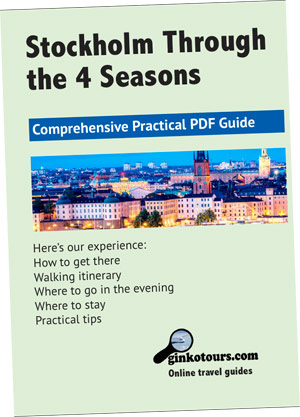
History of Stockholm
The history of Stockholm has its roots in the Middle Ages, with tradition attributing its foundation in 1252 to Birger Jarl, a powerful Swedish noble. However, the exact date of the foundation is still a subject of debate among historians. Over time, the city became a vital administrative and commercial center.
In the 16th century, Stockholm experienced significant growth in terms of economic and political importance, influenced by Renaissance architecture and establishing itself as a hub of trade and culture. In the 17th century, during the Thirty Years’ War, Sweden emerged as a European power, but the city witnessed crucial events, such as the fire at Tre Kronor Castle in 1697.
Subsequently, went through a period of Great Power, experiencing further economic and cultural growth. In the 19th century, it transformed into a modern industrial city, with the development of new infrastructure and communication routes contributing to urban development.
During both World Wars, Sweden maintained a neutral position, allowing Stockholm to avoid significant damage and becoming a refuge for artists and intellectuals fleeing conflicts. After World War II, Stockholm experienced considerable economic growth, transforming into a major financial and technological center.
With Sweden’s accession to the European Union in 1995, Stockholm contributed to increased economic and political integration with other European countries. Today, the city is modern and progressive, with a strong economy, a rich cultural heritage, and a high quality of life. Its history continues to shape the unique atmosphere and character of the city.
The life in Stockholm
The capital and largest city of Sweden, is located on the eastern coast of the country, where Lake Mälaren meets the Baltic Sea. This unique city consists of 14 interconnected islands connected by over 50 bridges, creating a picturesque landscape. The historic heart of Stockholm, Gamla Stan, is characterized by its narrow winding streets, colorful buildings, and historical monuments.
Notable for its rich cultural offerings, Stockholm boasts numerous museums, including the must-visit Vasa Museum, housing the 17th-century warship Vasa, and the National Museum, with an extensive collection of Swedish artworks. The city is the economic, political, and cultural center of Sweden, attracting multinational companies, financial institutions, and international organizations.
Stockholm offers an efficient public transportation system, including trains, buses, and the metro. During the summer, the city comes alive with cyclists, emphasizing its reputation as a bike-friendly destination. Not to be missed, the nightlife is vibrant, with numerous bars, clubs, and restaurants offering a variety of entertainment options. Stockholm also hosts cultural events and festivals throughout the year.
Considered one of the cities with the best quality of life globally, Stockholm captivates with its relaxed atmosphere, the beauty of the surrounding nature, and the efficiency of public services. In summary, Stockholm is a fascinating destination that offers a unique blend of history, culture, innovation, and a high standard of living.


